Secret of the High Priestess Spread
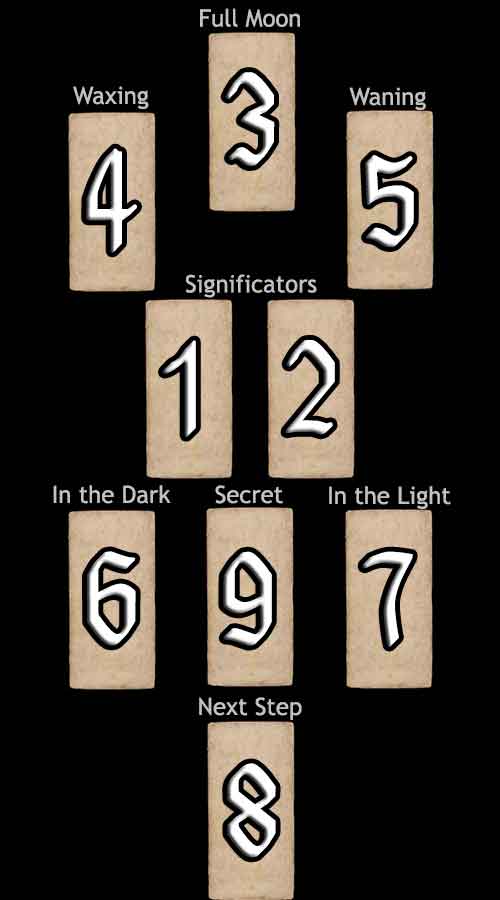
Difficulty: Average
This spread makes a nice alternative to the Celtic Cross, which covers basically the same ground. It is useful when a question doesn't quite call for the Ankh spread. This tarot spread is helpful for looking into a current trend. The High Priestess may or may not present a mysterious secret to be analysed after the rest of the spread.
1. & 2. Main impulses representing the topic at hand. They may compliment or oppose one another.
3. This is the current influence at this time.
5. The Waning Moon is the influence that is moving into the past.
4. The Waxing Moon indicates what is on the horizon, or the approaching influence. This is the immediate future.
7. The Light is what is clearly recognized, consciously.
6. The Dark indicates what is there but not fully perceived, though noticed on a deeper level of consciousness.
8. The Next Step is the near future, where this journey leads.
9. The final tarot card, only if it happens to be of the Major Arcana, reveals the Secret of the High Priestess. This is a special message that should be given added weight.
Your Secret of the High Priestess Reading
The Waxing Moon 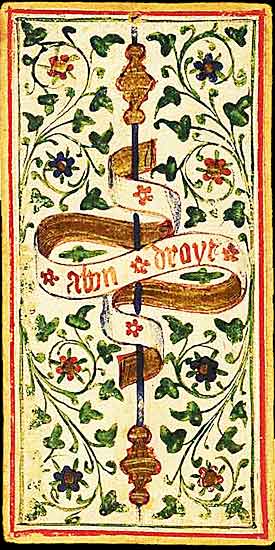 Ace of Staves |
The Full Moon 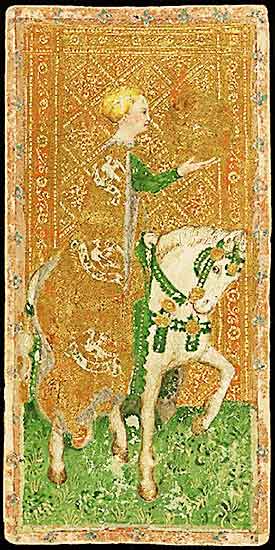 Knight of Coins (artwork from another Visconti deck) |
The Waning Moon 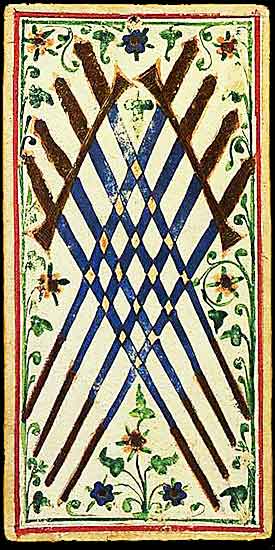 Eight of Swords |
|
Significator #1 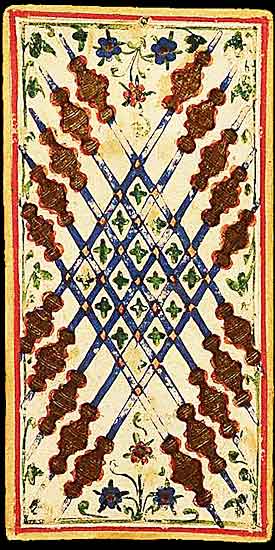 Ten of Staves |
Significator #2 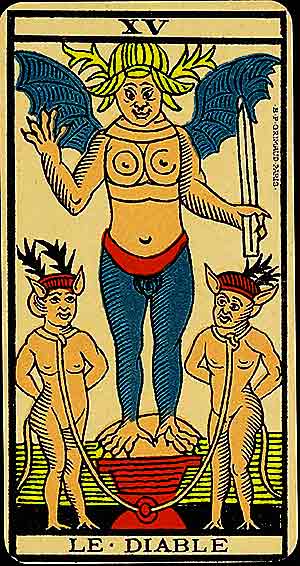 XV – The Devil (Lost card, substituted here) |
||
The Dark 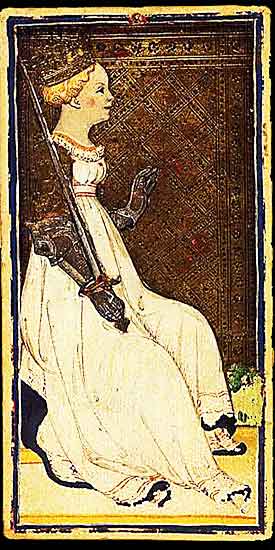 Queen of Swords |
The Secret of the High Priestess 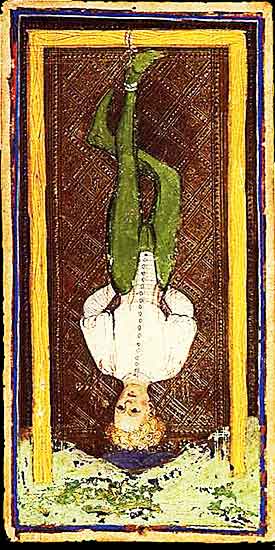 XII – The Hanged Man |
The Light 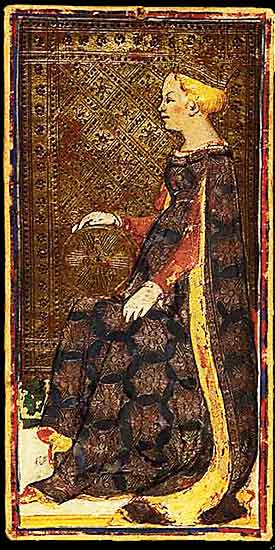 Queen of Coins |
|
The Next Step 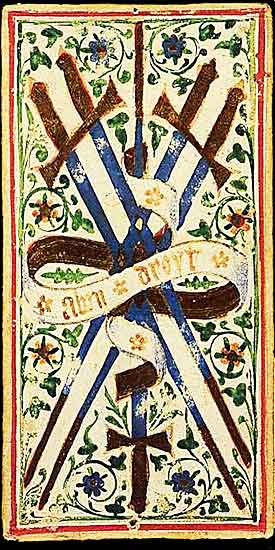 Five of Swords |
|||
Significator #1

Ten of Staves
The Ten of Staves represents burden, responsibility, and the weight of obligations. It suggests a time when you may feel overwhelmed or overextended by the demands placed upon you.
Symbolism: The ten staves, tightly clustered, evoke the image of a heavy load or responsibility that is difficult to bear. The densely packed design highlights the weight and complexity of the situation, while the pale tan background provides a calm counterpoint to the intensity of the composition.
In Relationships: Being overburdened by responsibilities or feeling weighed down by obligations. This card may indicate that you're taking on too much, or the relationship is becoming a source of stress.
In Work: A period of overwhelming responsibility or pressure at work. The Ten of Staves advises you to assess whether you are spreading yourself too thin or neglecting self-care.
Spiritually: Feeling weighed down by obligations or spiritual duties. You may be carrying too much responsibility, making it difficult to find peace or progress.
When ill-dignified: Burnout, exhaustion, or an inability to delegate. This card warns against carrying too much on your shoulders without seeking help or finding balance.
Significator #2

XV – The Devil (Lost card, substituted here)
This card no longer exists, so the Marseille version is filling in. The Devil represents bondage, temptation, and the shadow self. It highlights the chains we impose upon ourselves through fear, obsession, or indulgence, urging us to confront these darker aspects to reclaim our freedom.
Symbolism: The Devil embodies primal instincts and the seduction of material or carnal desires. The chained figures symbolise voluntary entrapment, their loose bindings reminding us of the ability to escape our vices. The pedestal signifies false power, while the scene hints at the potential for redemption through self-awareness.
In Relationships: The Devil warns of unhealthy attachments, jealousy, or manipulative relationships. It challenges you to examine whether passion has turned into obsession.
In Work: This card can signify being trapped in a toxic work environment, greed, or overreliance on material success. It urges you to reflect on what fulfils you.
Spiritually: The Devil calls for self-awareness and shadow work. Confronting your inner fears or desires will lead to personal liberation.
When ill-dignified: When reversed or ill-dignified, the Devil signifies breaking free from constraints, overcoming addiction, or realising what binds you.
The Waning Moon is the influence that you are putting behind you, as it moves into the past.

Eight of Swords
The Eight of Swords represents restriction, feeling trapped, and mental entanglement. It suggests a period of limitation or confusion, where you may feel stuck or constrained by your circumstances or thoughts. This card points to the mental barriers you may have created for yourself.
Symbolism: The interwoven swords evoke a sense of entrapment or restriction, highlighting how mental or emotional limitations can keep you bound. The design suggests the situation may be self-imposed, and the way forward is through clarity of thought.
In Relationships: Feeling trapped or restricted. The Eight of Swords suggests you may feel mentally or emotionally stuck, but the path to freedom lies in confronting your fears or limiting beliefs.
In Work: Mental or professional restrictions that prevent progress. This card encourages you to evaluate the factors keeping you stuck and break free from limiting patterns.
Spiritually: Spiritual imprisonment or being trapped in limiting beliefs. The Eight of Swords calls for introspection to uncover ways you might be blocking your own spiritual growth.
When ill-dignified: Overthinking, fear, or paralysis. The Eight of Swords warns against remaining in situations where you are not truly trapped but are instead allowing yourself to feel helpless.
The Full Moon is the current influence at this time.

Knight of Coins (artwork from another Visconti deck)
The Knight of Coins represents diligence, responsibility, and slow, steady progress. It symbolises a person dedicated to their work, committed to long-term goals, and willing to work hard to achieve success. This card speaks to patience and perseverance.
Symbolism: The steady horse and calm posture reflect the Knight's disciplined nature. The horse's grounded movement contrasts with the dynamic energy of other Knights, highlighting the Knight of Coins' deliberate pace.
In Relationships: Steady, dependable progress. The Knight of Coins represents a relationship based on responsibility, loyalty, and commitment.
In Work: Diligence and hard work towards career goals. The Knight of Coins emphasises patience and consistency in achieving professional success.
Spiritually: A time of steady spiritual progress. The Knight of Coins invites you to commit to your spiritual practices with consistency and patience.
When ill-dignified: Stagnation, stubbornness, or an inability to adapt. The Knight of Coins warns against becoming too rigid or focused on minor details, preventing growth.
The Waxing Moon indicates what is on the horizon; the approaching influence.

Ace of Staves
The Ace of Staves represents the spark of creation, vitality, and the raw energy of new beginnings. It embodies the potential of a seed, ready to sprout and grow into something magnificent. This is the card of inspiration, energy, and the initiation of new ventures.
Symbolism: The upright staff, with its textured bark and emerging sprout, symbolises the beginning of a new cycle, full of potential and promise. The plain tan background highlights the purity and simplicity of the elemental energy, inviting you to step forward with enthusiasm and confidence. The sprout near the base reminds you that all growth begins with a single step.
In Relationships: A new beginning or a burst of passion in your romantic life. The Ace invites fresh energy and the excitement of new connections or the rekindling of a relationship.
In Work: The birth of a new project or opportunity. The Ace of Staves signals that now is the time to seize your creative potential and pursue your ambitions.
Spiritually: A call to action. The Ace suggests you are on the verge of spiritual awakening or taking a new path. Trust your instincts and take the first step towards growth.
When ill-dignified: Lack of direction or motivation, possibly feeling uninspired. You may be hesitant to begin, caught in uncertainty or fear of failure.
The Light is what is clearly recognized.

Queen of Coins
The Queen of Coins represents nurturing, abundance, and practical wisdom. She is a motherly figure who embodies warmth, security, and the ability to create a stable and prosperous environment for others. This card speaks to a balance of generosity, practicality, and a grounded approach to material wealth.
Symbolism: The Queen's regal yet nurturing posture, along with her detailed gown and the coin she holds, reflects her ability to create abundance through care, planning, and attention to detail. The golden tapestry symbolises wealth and elegance.
In Relationships: A loving, supportive partner who creates a warm, stable home. The Queen of Coins encourages a relationship rooted in care, nurturing, and shared prosperity.
In Work: A grounded, practical approach to career success. The Queen of Coins suggests using your skills to create financial security for yourself and others.
Spiritually: Spiritual abundance through nurturing practices. The Queen of Coins advises using your spiritual wisdom to care for yourself and others.
When ill-dignified: Over-protection, possessiveness, or neglecting your own needs for the sake of others. The Queen of Coins warns against being controlling or too focused on material wealth.
The Dark shows what is there but not fully perceived, though it has been noticed on a deeper level of consciousness.

Queen of Swords
The Queen of Swords represents clarity, independence, and intellect. This card signifies a woman who is wise, perceptive, and quick-witted. She embodies the ability to cut through confusion and speak truth while showing compassion and understanding.
Symbolism: The Queen's commanding yet calm demeanour and careful posture symbolise authority in both intellect and emotions. Her elegant surroundings highlight her wisdom and stature.
In Relationships: Emotional independence and clear communication. The Queen of Swords suggests you can navigate relationships with clarity and a balanced approach.
In Work: The ability to lead with intellect, discernment, and clear communication. This card represents mental sharpness and decisive action in your professional life.
Spiritually: A time of mental clarity and spiritual discernment. The Queen of Swords encourages you to cut through illusions and pursue truth in your spiritual path.
When ill-dignified: Coldness, bitterness, or being harsh. The Queen of Swords warns against using your intellect as a tool for manipulation or becoming too detached from your emotions.
The Next Step is the near future, where this journey will take you.

Five of Swords
The Five of Swords represents conflict, competition, and mental struggle. It suggests a situation where victory may come at a cost, with tension and discord present. This card can indicate a win achieved through manipulation, dishonesty, or at the expense of others.
Symbolism: The swords are arranged in an unbalanced formation of four-on-one, highlighting the disharmony and imbalance created by conflict. The uneven positioning of the blades reflects the instability caused by mental or emotional discord, while their fine craftsmanship hints at the complexity of the situation.
In Relationships: Conflict or mental challenges. The Five of Swords suggests that a fight or disagreement may have left scars, and one must decide whether to continue fighting or walk away.
In Work: A competitive or combative environment. This card warns that achieving success at the expense of others may lead to resentment or long-term harm.
Spiritually: Mental conflict or inner turmoil that disrupts your peace of mind. The Five of Swords advises resolving spiritual disputes and finding reconciliation within yourself.
When ill-dignified: Deception, defeat, or unnecessary conflict. The Five of Swords warns against manipulative behaviour or unnecessary mental battles that lead to no real resolution.
The Secret of the High Priestess - if, and only if, this card a Major Arcana, it reveals the Secret of the High Priestess. This is a special spiritual message that you should pay extra special attention to. If it is not a trump, the Priestess has revealed no secret.

XII – The Hanged Man
The Hanged Man represents a moment of suspension, transformation, and the profound wisdom of surrender. It is the card of acceptance, urging one to release control and embrace a new perspective, even at the cost of discomfort.
Symbolism: The figure's suspended position signifies the state of hanging between worlds, a soul caught in the liminal space between the old and new. The calm expression of surrender contrasts with his precarious state, highlighting the necessity of letting go to gain understanding. The patterns of his tunic, combined with the golden glow, evoke a sacred pause in time, elevating this card to a spiritual level.
In Relationships: A time to step back and reassess your emotional life. Patience, understanding, and self-reflection are required. The card suggests moments of stillness can lead to profound growth in relationships.
In Work: Professional progress comes through rethinking old strategies. The Hanged Man indicates that a temporary pause or a shift in perspective can lead to breakthroughs.
Spiritually: The card speaks to spiritual enlightenment through sacrifice and release. You are called to surrender to the flow of life and gain higher wisdom.
When ill-dignified: Resistance to change, stagnation, and a refusal to let go. This warns against being trapped by fear or obstinance, preventing personal growth.